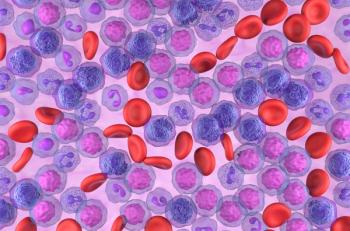
Novel PET Imaging Agent Earns Fast Track Status for PSMA+ Prostate Cancer
In 2 clinical trials, 64Cu-SAR-bisPSMA was shown to be effective in detecting prostate cancer in patients with PSMA-positive lesions.
The FDA has granted 64Cu-SAR-bisPSMA fast track designation for PET imaging of prostate-specific membrane antigen (PSMA)–positive prostate cancer lesions with suspected metastases eligible for initial definitive therapy, according to a news release from the developer, Clarity Pharmaceuticals.1
“Receiving fast track designation for 64Cu-SAR-bisPSMA is a significant milestone, especially as we are actively recruiting into our first registrational phase 3 trial, CLARIFY [NCT06056830], and preparing for an end of phase meeting with the FDA for a second pivotal phase 3 trial with this product,” Alan Taylor, PhD, executive chairperson of Clarity Pharmaceuticals, said in the news release.1 “The designation will allow us to work closely with the FDA to facilitate the development process, potentially accelerating the approval of this best-in-class diagnostic.”
Data from the phase 1 PROPELLER trial (NCT04839367) presented at the
Additionally, greater uptake was observed with 64Cu-SAR-bisPSMA vs 68Ga-PSMA-11, the FDA approved standard of care for prostate cancer detection. The reader 1 median maximum standard uptake values (SUVmax) were 31.40 (IQR, 27.45) with 64Cu-SAR-bisPSMA vs 10.08 (IQR, 13.92) with 68Ga-PSMA-11. Median SUVmax were 41.00 (IQR, 46.09) vs 14.58 (IQR, 14.98), respectively, for reader 2 (P < .001).
Furthermore, median tumor-to-background ratios (TBR) were 49.07 (IQR, 67.69) with 64Cu-SAR-bisPSMA vs 21.91 (IQR, 35.71) with 68Ga-PSMA-11 (P = .0015) for reader 1. Reader 2 median TBR values were 76.34 (IQR, 66.37) vs 23.90 (IQR, 33.05), respectively (P < .001). Additionally, a single grade 1 treatment-related adverse effect (TRAE) was found with 64Cu-SAR-bisPSMA.
Investigators of the phase 1 trial enrolled 30 adult male patients with histopathologically confirmed, previously untreated intermediate- to high-risk primary prostate cancer. Patients initially received standard 68Ga-PSMA-11 followed by PET/CT at 1 hour after dosing. Then, patients received 100 MBq, 150 MBq, or 200 MBq of 64Cu-SAR-bisPSMA with PET/CT scans occurring 2 to 4 hours post dose.
The trial’s dual primary end points were safety and tolerability of 64Cu-SAR-bisPSMA and efficacy of 64Cu-SAR-bisPSMA.3 The secondary end point of the study was image quality comparison of 64Cu-SAR-bisPSMA for each dose level.
Data from the phase 1/2 COBRA trial (NCT05249127), presented at the
Investigators of the phase 1/2 study enrolled 52 patients with prostate cancer with biochemical recurrence (BCR) and negative or equivocal standard of care imaging, of which 32 completed the study. Patients in the study received 200 MBq of 64Cu-SAR-bisPSMA and underwent PET/CT on days 0 and 1.
The trial’s primary end points were safety, detection rate, and PPV.5 Secondary end points included biodistribution, false positive rate, discrepant PET negativity rate, and true negative rate.
“We believe that 64Cu-SAR-bisPSMA could be a game changer in prostate cancer diagnosis. Due to its dual targeting structure, bisPSMA, and the longer half-life of copper-64, enabling next-day imaging, this unique product has shown higher tumor uptake and retention and exhibited a capability of detecting much smaller lesions,” Taylor concluded.1
References
- Clarity receives FDA Fast Track Designation for 64Cu-SAR-bisPSMA. News release. Clarity Pharmaceuticals. August 22, 2024. Accessed September 27, 2024. https://tinyurl.com/2hw9bumt
- Lengyelova E, Wong V, Lenzo N, et al. 64Cu-SAR-bisPSMA (PROPELLER) positron emission tomography (PET) imaging in patients with confirmed prostate cancer. J Clin Oncol. 2023;41(suppl 16). doi:10.1200/JCO.2023.41.16_suppl.5039
- Positron emission tomography (PET) imaging of participants with confirmed prostate cancer using 64Cu-SAR-bisPSMA (PROPELLER) (PROPELLER). ClinicalTrials.gov. Updated January 17, 2023. Accessed September 27, 2024. https://tinyurl.com/mrmt6zbx
- Nordquist L, Lengyelova E, Saltzstein D, et al. COBRA: assessment of safety and efficacy of 64Cu-SAR-bisPSMA in patients with biochemical recurrence of prostate cancer following definitive therapy. J Clin Oncol. 2024;42(suppl 16). doi:10.1200/JCO.2024.42.16_suppl.5100
- 64Cu-SAR-bisPSMA for identification of participants with recurrence of prostate cancer (COBRA) (COBRA). ClinicalTrials.gov. Updated July 22, 2024. Accessed September 27, 2024. https://tinyurl.com/2dcnczmd
Newsletter
Stay up to date on recent advances in the multidisciplinary approach to cancer.


















































































